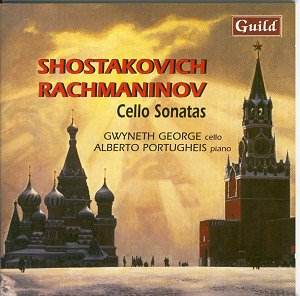My love for cello music is well known. To add to the
interest of this disc Gwyneth George comes from Swansea. Snap! She has
studied with Enrico Mainardi and Paul Tortelier. I have had the pleasure
of talking to Alberto Portugheis and his recordings of Ginastera’s piano
music are a must for listeners but only great pianists need buy the
music with a view to playing it. He is a fine player and a modest man.
So I was almost converted to the disc before I listened to it.
I was not disappointed. The balance is truly admirable
and the big Rachmaninov chords do not swamp the cellist. Pianists like
Richter and Barenboim did just this producing a graveyard of instrumental
soloists that they accompanied. The Rachmaninov sonata is a fine piece.
No one could mistake it for the work of any other composer. I have never
heard the scherzo second movement played better. It is, a complete revelation
and I have known and loved this sonata for almost 40 years and used
to play it. The menace is truly wicked and the slow movement is a testament
of humanity. All feeling is here. Here is writing that any composer
should study to see how to produce a truly brilliant slow movement.
And these excellent performers avoid sentimentality. My word, this is
good! The finale is a good example of nobility in music without pomposity
or indulgence. The tender second subject is marvellously realised. The
question is: why did Rachmaninov write a sonata for cello? Why not a
violin? Is it because Dr Dahl was a amateur cellist? Whatever the reason
I am glad that he did. It is really a splendid piece.
The Shostakovich is a good piece but I have reservations
about it - particularly the frantic scherzo. The second movement, it
is what I call 'locomotive music' and repeated piano notes. The high
broken quick chord figures on the cello are irritating. The cello is
a beautiful instrument and does not lend itself to shrieks however subdued
Shostakovich makes them. But this is a fine performance, straightforward,
lacking in any excesses. It is honest - letting the music speak for
itself. There are moments in the slow movement that are too beautiful.
As for the finale I am not sure that Shostakovich’s sardonic humour
suits the cello. It certainly suits the piano. The music is simple but
perhaps a little banal. And can you detect Haydn’s Surprise Symphony
here? But the performance is convincing and I enjoyed it!
David Wright
Hubert Culot has also listened to this disc
Rachmaninov composed comparatively little chamber music,
i.e. if one excepts his numerous pieces for piano or two pianos. Besides
his Trio Elégiaque No.1 (1892) and the substantial
Trio Elégiaque No.2 (1893) in memory of Tchaikovsky,
the Sonata in G minor Op.19 for cello and piano, completed
in 1900, following three fallow years after the disastrous première
of his First Symphony, is his most important chamber work. It is on
a grand scale: a lengthy first movement with a long introduction leading
into an Allegro moderato roughly cast in sonata form. This is
followed by a somewhat fantastical Allegro scherzando alternating
nervous gestures and a more relaxed melody. The lyrical and nostalgic
Andante rises to an impassioned climax after which the intensity
recedes before a last fit of passion. This warmly romantic piece is
capped by a lively Allegro mosso which eventually concludes the
sonata in a brilliantly affirmative mood.
Shostakovich’s Cello Sonata Op.40 was
completed in 1934, i.e. in a period of great personal turmoil and –
most importantly – after the completion of his opera Lady Macbeth
of Mtensk which would soon cause Stalin’s rage and put Shostakovich
in a difficult situation vis-à-vis the régime.
The impact of censure on Shostakovich’s musical progress had him adopting
a rather ambiguous attitude throughout the rest of his creative life.
As a further result, his chamber works will always be deeply personal
statements and, to a certain extent, reveal the "real" Shostakovich.
However, his Cello Sonata predates the revelatory set of string quartets
and, as already mentioned, has a close connection with the composer’s
intimate life at the time of its composition. As Rachmaninov’s Cello
Sonata, it is a big romantic piece although Shostakovich’s lyricism
is completely his own. The piece brims with long passionate melodies,
whenever necessary, as in the first and third movements. The first movement
Allegro non troppo’s structure has much in common with that of
Rachmaninov’s piece. It is also followed by a Scherzo, a moto perpetuo
driven along by ostinati (in fact a typical Shostakovich scherzo).
The slow movement is a rather oppressive meditation (one sometimes thinks
of the Largo of the Fifth Symphony or the impressive Passacaglia
of his First Violin Concerto). Quite characteristically also, Shostakovich
concludes his Cello Sonata with a lively, slightly sardonic Rondo.
Both pieces have in fact much in common, be it in their
global structure or in their emotional background. Both are also highly
characteristic of their respective composer, coincidentally both in
their early thirties at the time of composition. As such this coupling
is quite revealing in spite of the enormous stylistic gaps between both
composers.
The present performances, recorded as far back as 1970
and 1971, are very fine and quite satisfying, though the recorded sound
may at times show its age. There may be better performances available
around (I for one still cherish Heinrich Schiff’s wonderful performance
of Shostakovich’s Cello Sonata recorded by EMI years ago) but these
performances have much to offer.
Jonathan
Woolf also reviewed this last month

![]() Gwyneth George (cello)
Alberto Portugheis (piano)
Gwyneth George (cello)
Alberto Portugheis (piano)![]() GUILD GMCD 7219 [54.56]
GUILD GMCD 7219 [54.56]